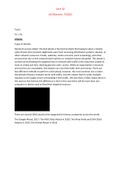Essay
BTEC Level 3 Computing Unit 32 Distinction grade Networked Systems Security
- Institution
- PEARSON (PEARSON)
This is the full assignment for Unit 32 in Networked Systems Security in my level 3 BTEC Computing. I have received a grade of Distinction and an overall grade of D*D*D* in the first year. The information in the document is detailed ad
[Show more]



